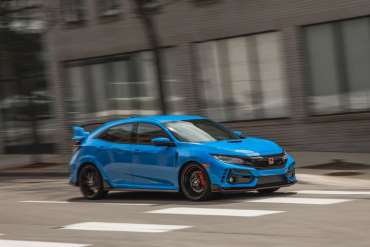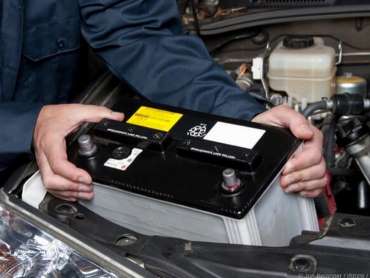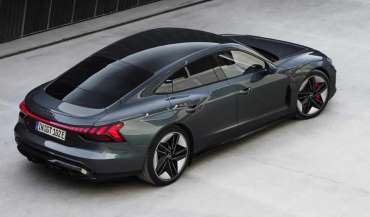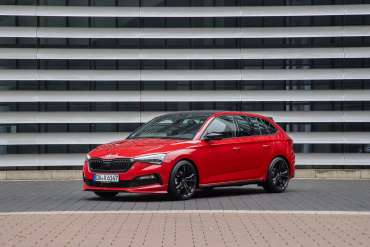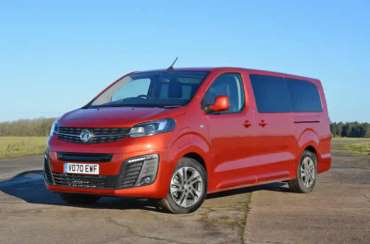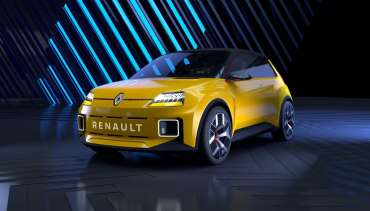
Worldcarblog.com
Tested: 2020 Honda Civic Type R Refines a Great Hot Hatch
Honda makes the bonkers Civic even better by adding features, retuning the chassis, and tweaking the hatchback's still polarizing styling.
Everyone is seeking a distraction these days. The crumbs collecting in the seat of our racing simulator and the growing pile of empty cans beside it suggest that we've spent an unhealthy number of hours lapping computerized cars around circuits in Forza Motorsport. Perhaps it's the fleeting pleasure those pixelated races provide that made our hands-on experience with the revised 2020 Civic Type R feel like Honda gave us a healthier way to seek catharsis.

In southeast Michigan, our favorite paved playground, the loop we employ to select our 10Best list every year, lives close by. The drive there includes enough highway time to allow plenty of peepers to gawk at the Type R's gloriously juvenile bodywork. Its bulging front fenders, countless aero bits, and distracting (yet functional) wing are made more obvious by the Type R's new brilliant Boost Blue hue, which is the least subtle update Honda introduced on the 2020 Type R. (We expect an all-new Civic Type R for the 2022 model year). Other exterior revisions include body-colored trim on both bumpers, a larger grille opening that improves engine cooling, and, to add back some lost downforce from the new grille, a reshaped front spoiler. While nothing will ever convince the haters that this Civic looks badass, it's hard to deny that the Japanese-designed Batmobile draws as much attention as significantly more expensive metal. Apart from some dealer-installed accessories, the no-cost paint colors are the only options. Our 2020 copy cost $37,990, which is only $735 more than it did last year.
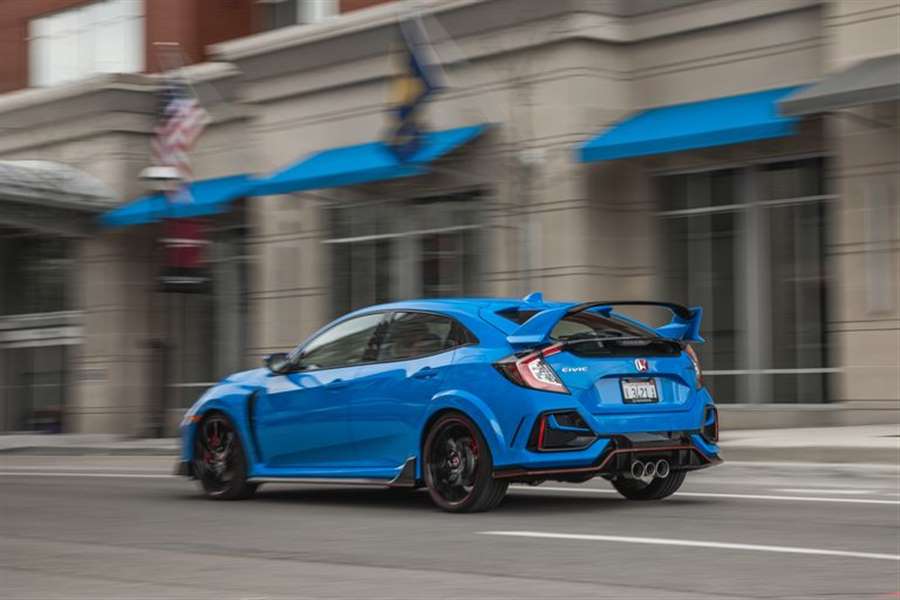
HIGHS: Unflappable poise, excellent turbo-four engine, daily driver livability.
The Type R looks as out of place on the interstate as Marilyn Manson performing at Sunday service. Although our long-term 2019 Civic Type R has revealed that extended road trips are not this car's strong suit, we had just a short interstate blast in the 2020 car before we reached our destination. Those outrageously red front seats are more comfortable than they look. And like lesser Civic hatches, the Type R has an Uber-grade back seat and sizable cargo space behind it. The 2020 model replaces the leather on the steering wheel and shift boot with a racier microsuede material. A new teardrop-shaped shifter hides a 90-gram counterweight to deliver better feel. Somewhat surprisingly, Honda kept the aluminum knob, which burns your hand in the summer and bites it in the winter.
The 2020 Type R's turbocharged 2.0-liter inline-four makes the same healthy 306 horsepower and 295 pound-feet of torque as before. That power is dispatched to the front wheels through a helical limited-slip differential and a six-speed manual transmission, which has short gearing that prioritizes rapid acceleration. While the engine starts making power around 2500 rpm, the party is pretty tame until the tach needle passes 3500 rpm, unleashing a thrilling blast to redline that conjures the high-revving VTECs of yore. It also provides enough shove to ensure that the Daewoo Lanos with a duct-taped wing that's lingering in your mirrors can only dream about overtaking you.

In the 2020 model, we recorded a 4.9-second dash to 60 mph and a quarter-mile pass of 13.4 seconds at 108 mph—solid runs that are both impressive for a front-wheel-drive car and similar to those of previous Type Rs we've tested. But the hottest Civic's reign as the quickest front-driver has come to an end. The updated 2021 Hyundai Veloster N with its new optional automatic transmission just beats the Honda to 60 mph by a tenth of a second. The 302-hp 2020 Mini John Cooper Works GP is a tenth quicker still to 60 mph (4.7 seconds) and posts an even stronger 13.1-second quarter-mile at 110 mph. Even more significant is that the Mini GP snagged the title of fastest front-driver ever at this year's Lightning Lap, beating the Type R's time around our 4.1-mile configuration at Virginia International Raceway by just 0.1 second.
LOWS: No longer the quickest hot hatch, love-it-or-hate-it styling persists, still doesn't sound as good as it drives.
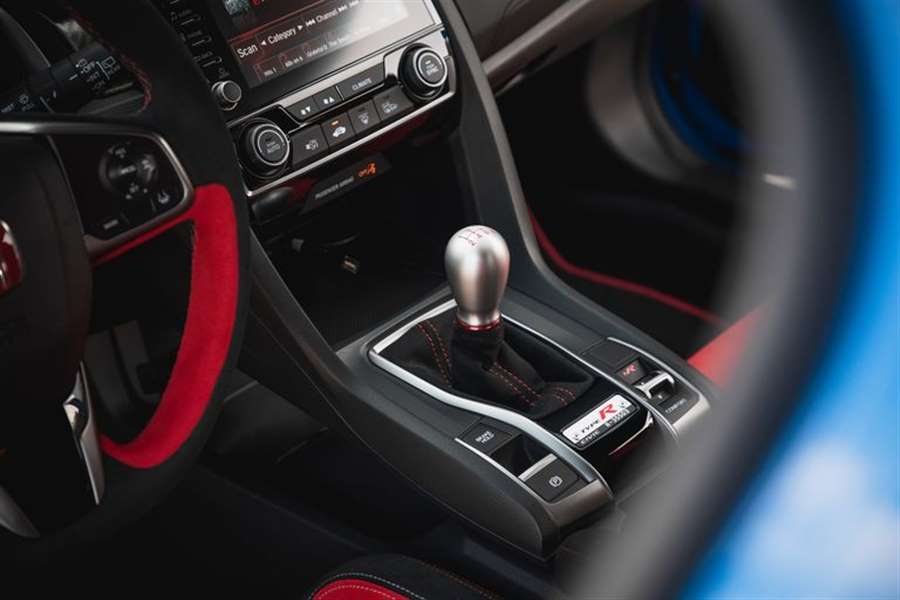
The Type R’s trademark triple-outlet exhaust issues a droning boom unless you’re working the engine hard enough to push exhaust through the center pipe and its resonator. The odd arrangement is intended to add character to the engine's soundtrack, but it only emphasizes our disappointment. The mightiest Civic sounds subdued, especially compared with the firecracker soundtrack of the Veloster N. Honda apparently realized this disparity and sought redemption by installing Active Sound Control on all 2020 models. This new feature artificially enhances the Type R's engine sounds using the audio system, and the intensity increases as you move through the drive modes. Too bad it's really only noticeable during large blips of the throttle—during heel-and-toe maneuvers or rev-matched downshifts—but even then, it just sounds like an auto-tuned bumblebee blasting from the speakers. The 88 decibels we recorded at full-throttle and 74 decibels at a 70-mph cruise are in line with other Type Rs we've measured, although those figures are 3 and 2 decibels quieter, respectively, than what our long termer produced when it was new.
As we approached the hard right turn that begins the clockwise circulation of the loop, we killed the climate system and the radio to focus on the Type R's chassis improvements. The 2020 car gets new lower-friction ball joints and updated bushings for the front suspension, revised rear bushings that are stiffer laterally, and retuned adaptive dampers that now sample the road 10 times quicker. The front brakes are fitted with more fade-resistant pads and new two-piece floating rotors that are no longer cross drilled that cut unsprung weight by 2.5 pounds per side. These careful tweaks are hard to perceive without driving the new and old models back-to-back, and they don't produce any measurable difference at the test track. The 2020 model returned a familiar (and excellent) 1.03 g of grip around the skidpad and a 148-foot stop from 70 mph. However, we did notice the new car's firmer brake pedal, which Honda says has 17 percent less initial lost motion before the pads meet the rotors (and the Type R already had spectacularly good brake feel).
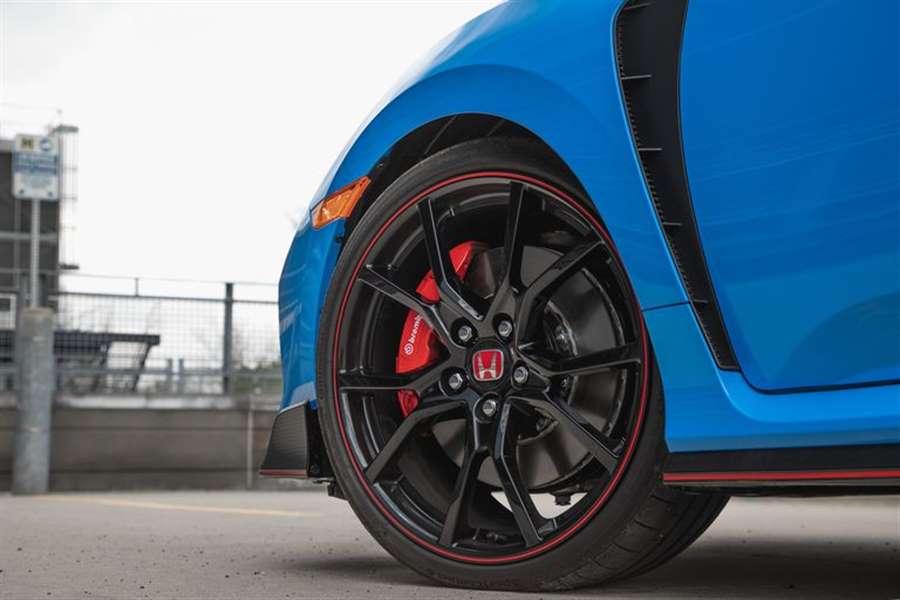
Our route includes several places where you can accelerate hard from a stop, and that’s one of the few situations where the Type R’s front-wheel-drive layout feels like a liability. The car's Continental SportContact 6 tires—sized 245/30ZR-20 all around—frantically scramble for traction as the turbo spools up and the tach approaches the 7000-rpm redline. While the front tires struggle to find grip right off the line, they’re at least not tugging toward the ditch, as the Type R's dual-axis strut front suspension magically vanquishes the dreaded front-drive torque steer. Once you’re moving, flowing along a ribbon of twisty road in third gear, the lack of all-wheel (or rear-wheel) drive feels irrelevant.
Despite pancake-thin sidewalls and huge 20-inch wheels, the Type R’s ride is almost unbelievably free from the expected jolts and jitters. While there's a noticeable change between the softest damper setting (Comfort) and the firmest (Plus R), the Civic feels unflappable in either mode while roller-coasting up and down the loop's esses. Steering effort incrementally increases with each of the three drive modes (the default, appropriately, is Sport) and every note reminds us of Porsche's divine composition.
The talkative wheel is a major factor in the Type R's preternatural ability to turn any road into a racetrack. This is a car that transforms grocery runs into hot laps, commuting into rally stages. While it shares an aging infotainment system and its standard driver-assistance features (such as adaptive cruise and lane-keeping assist, which are new for 2020) with the regular Honda Civic hatch, the alpha-dog model looks and feels like an altogether different car. It’s a raw, visceral machine, an IRL antidote to virtual living. You might have a million-dollar racing simulator, but those screens can’t compare with the view through a Type R’s windshield.
Mercedes is towing vehicles due to a fault in the emergency call system
More than 1.3 million Mercedes Benz vehicles will be withdrawn, because the emergency call system can send the wrong location after the accident due to a software error.
The car manufacturer made that decision after the accident that happened in Europe when the automatic system sent the wrong location of the vehicle.
During the investigation that began in October 2019, more similar cases were discovered, but according to the company's spokesperson, none in the United States.
Mercedes will withdraw a large number of vehicles from 2016 to 2021, including the CLA, GLA, GLE, GLS, SLC, A, GT, C, E, S, CLS, SL, B, GLB, GLC and G classes.
Daimler has announced that it will also withdraw the Metris 2016-2020 and Sprinter 2019-2020 cars.
Mercedes-Benz announced that it will inform the affected owners and update the software systems free of charge.
The withdrawal of the car is expected to begin on April 6.
Is it possible to drive a car without a battery?
Judging by the fierce discussions on specialized forums, the issue of battery-free driving haunts many curious minds. Common sense dictates an instant answer that on modern cars, full of electronics prone to breakdowns, it is better not to subject the vehicle to such experiments and that the risk of a photo of a breakdown on one of the systems is too high. But is it really dangerous to drive a car without a battery? Let's try to answer this question a little more meaningfully.
Life writes novels and you are never sure what tomorrow will bring you. Today, we are interested in this topic out of purely academic motives, out of curiosity or curiosity, and as much as, God forbid tomorrow, by an unfortunate coincidence we can get into a situation to test our knowledge in practice.
"What has to happen to me to have to drive a car without a battery?" Well, imagine a battery falling into a coma due to a short circuit or some other unfortunate set of circumstances. You do not have the ability to quickly replace the device with a correct one, but you urgently need a car.
After all, someone can steal a battery, and then what do we do?

The first problem that a driver who is determined to drive a car without voltage will probably face is how to start the engine. The chances of waking up the engine as illustrated in the photo, that is, "on the gurk" are small: a discharged battery will not excite the starter winding. You can rely on the self-propelled starter, but the car will have to push or go downhill for a long time - at least up to 3,000 rpm.
Another option is to connect the start-up cables to another, working battery and wake it up. But this is extremely dangerous regardless of whether the "donor" battery is completely correct or not. This can be dangerous for both our car and the "donor". That is why it is best to use a fast, that is, smart charger in such a situation. The main thing is to charge the battery and produce a current of at least 300A. This of course depends on the characteristics of the unit in our vehicle.
Suppose we managed to start the engine. What's next, can I go? If the answer is yes, then the question remains, how long can I drive like this?
Here, it is important to keep in mind that the battery has a charge, not only to supply consumers, but also to equalize the voltage, equalize the current fluctuations. Driving without a battery in a prehistoric car with a minimum of electronics is not fatal and is generally not questionable. As for modern cars, everything is much more complicated here: in the worst case, the "brain of the vehicle" can fail due to an electric shock, and that will undoubtedly cost the owner a considerable figure.

For this reason alone, it is better not to drive without a battery. However, if there is no other way out, then you need to pay special attention to the insulation of the positive end from the body. The inclusion of all possible consumers of electricity will help minimize the effects of voltage surges: lighting devices, multimedia, heated rear window, heated seats. And don't try to set a record in the distance traveled without a battery: head to the nearest auto parts store for a new battery.
As practice shows, a lot here depends not only on the design characteristics of the car and the condition of the device, but also on the actions of the driver and mere, banal luck. For example, one curious experimental character who shared his experience on the Internet successfully drove a ten-year-old Renault Megane without a battery. And the other - he managed to burn the ignition coil on the VAZ "kopeck" 15 minutes after the start.
AutoRepublika
Audi E-Tron GT first details
Scorching-looking electric coupe from Audi targets the Tesla Model S
Audi has unveiled off its latest electric car, the new E-Tron GT. It's the second bespoke EV in the Audi range, and is closely based on the highly impressive Porsche Taycan. It's a four-door coupe that's set to go on sale in the UK later in 2021.
As well as sharing its basic proportions with the Porsche Taycan, the E-Tron GT will look familiar to anyone who is familiar with industry news. It is very similar to the concept car of the same name first shown at the Frankfurt motor show back in 2018. It's unusual to see a production car look so like a concept car like that, but this is no bad thing.
When it goes on sale, the cars it needs to beat will be the Porsche it's so closely based on and the evergreen Tesla Model S, which has just received a raft of improvements for the 2021 model year. Audi will have an advantage in terms of build quality and interior finish, but the Tesla gets a massive advantage from its Supercharger network of high-speed public chargers.
From launch, buyers will have a choice of two models: the e-tron GT quattro and RS e-tron GT. Both versions use an electric powertrain featuring a motor mounted on each axle for four-wheel drive.
What's it like inside?
If you've experienced any top-end Audi launched since the current A8, the interior of the E-Tron will will reassuringly familiar. It loses that car's three-screen set-up, but you still get the latest 12.3-inch Virtual Cockpit instrumentation as well as a generously-proportioned 10.1-inch central screen for the infotainment set-up. There are physical buttons for the climate control system.
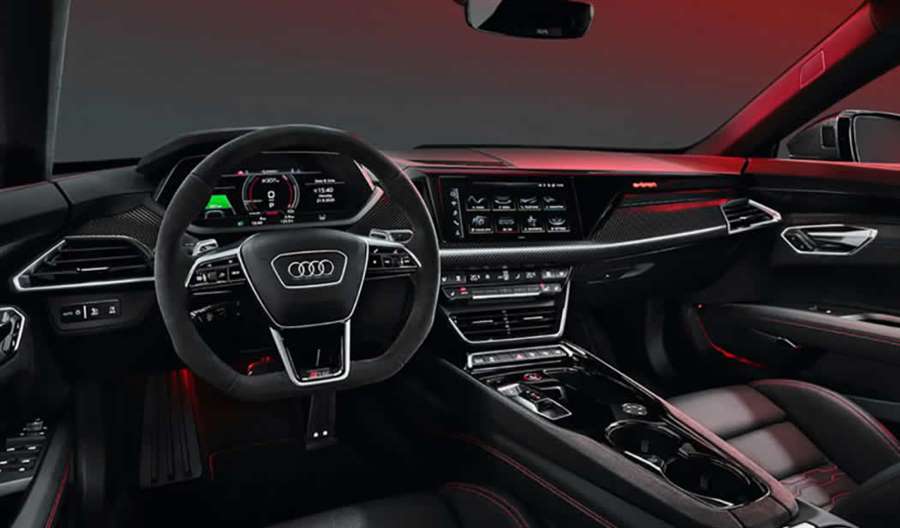
In addition, it's packed with equipment as you'd expect - so there are heated seats, user-configurable interior lighting, and these can be individually set-up for up to six users. There's an optional head-up display, and you can control all of this via the screens, buttons on the wheel and by Audi's latest iteration of its voice recognition system. You can also specify it with an autonomous self-parking system.
There are Vegan trim options including Dinamica and Kaskade, which are supposed to feel like Alcantara and wool. The more-sporting RS E-Tron GT will be available with microfibre trim for the dashboard and contrasting stitching for the steering wheel and centre console. You want open-pore walnut or carbon fibre? They're all there for you.
Practicality should like the Porsche Taycan - so a generous interior for four people, while Audi says the luggage capacity is 405 litres - about the same as a Volkswagen Golf with the rear seats in place.
Audi E-Tron GT charging and range
Audi is going for maximum efficiency here. It's super-sleek for the least air resistance at speed. Audi says that the new E-Tron GT has a drag coefficient of just 0.24Cd, which means it has one of the most aerodynamic bodies on sale today. What that means for you is that there will be low levels of wind noise at speed, and it will go longer without stopping on the motorway.
Both the E-Tron and RS E-Tron GT have the same generously-sized 93kWh battery pack (with a usable capacity of 85kWh). Audi says that will deliver a maximum range of 298 miles, although official figures are yet to be released.
The E-Tron GT will accept the latest rapid chargers, like the Porsche Taycan. What that means is you'll be able to hook it up to a 270kW public charger and give it an 80% charge in just 23 minutes. Or to put it another way, you'll get 62 miles of range for every five minutes of rapid charging. On a standard UK domestic wallbox, to fully recharge from empty will be an overnight operation, while using a three-pin plug should be just for emergencies...
How fast is it?
If you're looking for a surge of electric acceleration, you won't be disappointed. The entry-level E-Tron GT develops 475hp for a claimed 0-62mph time of 4.1 seconds. Maximum speed is 152mph, but as you can imagine, battery range will be severely compromised the closer you get to that speed.
The RS E-Tron GT is considerably quicker and more powerful. Maximum power is 600hp, although the car’s launch control system can temporarily increase power to 655bhp. Acceleration is boosted - 0-62mph time comes in at 3.3 seconds and the maximum speed goes up to 155mph (limited).
The RS E-Tron gets performance upgrades including uprated tungsten-carbide-coated brake discs, adaptive air suspension and optional four-wheel steering for improved high-speed stability. Handling on all models will benefit from its sophisticated double-wishbone suspension and electronically controlled dampers.
RS E-Tron upgrades
The sporting RS models will be available from launch and come with a whole range of upgrades to reflect their status as the ultimate E-Tron GT. It's visually different with a restyled bonnet and a sportier-looking bodykit. The front bumper is also deeper, while at the rear you get a less subtle-looking diffuser. Adaptive dampers lower the car at speed, while laser headlight technology on the RS will make night driving easier.
How much does it cost and when is it on sale?
The E-Tron GT will launch in two versions, the E-Tron GT Quattro and the RS E-Tron GT. Both go on sale in spring 2021 with UK deliveries to follow shortly after. The prices of all the various trims can be found below.
E-Tron GT quattro £79,900
E-Tron GT quattro Vorsprung £106,000
RS E-Tron GT £110,950
RS E-Tron GT Carbon Black £124,540
RS E-Tron GT Vorsprung £133,340
Skoda, in cooperation with ABT, has prepared a special edition of the Scala model with 190 hp
The German branch of Skoda, together with the tuning company ABT, has prepared a special edition of the Scala model. The car is characterized not only by significantly enhanced drive, but also an extremely attractive appearance.
With the help of ABT, the Czech manufacturer has improved the Scala, which has 190 horsepower in the sporty S version. Skoda's German division has teamed up with the well-known factory for finishing factory models, the company ABT, and the result is the powerful Scala Edition S.
The car is powered by an existing 4-cylinder 1.5-liter TSI turbo-petrol engine with 150 hp, from which ABT has extracted an additional 40 hp and 40 Nm. In this way, the Skoda Scala Edition S got an engine with 190 "horsepower" and 290 Nm. A 6-speed manual transmission is used for power transmission, so this Scala is the right car for traditional sports driving fans.
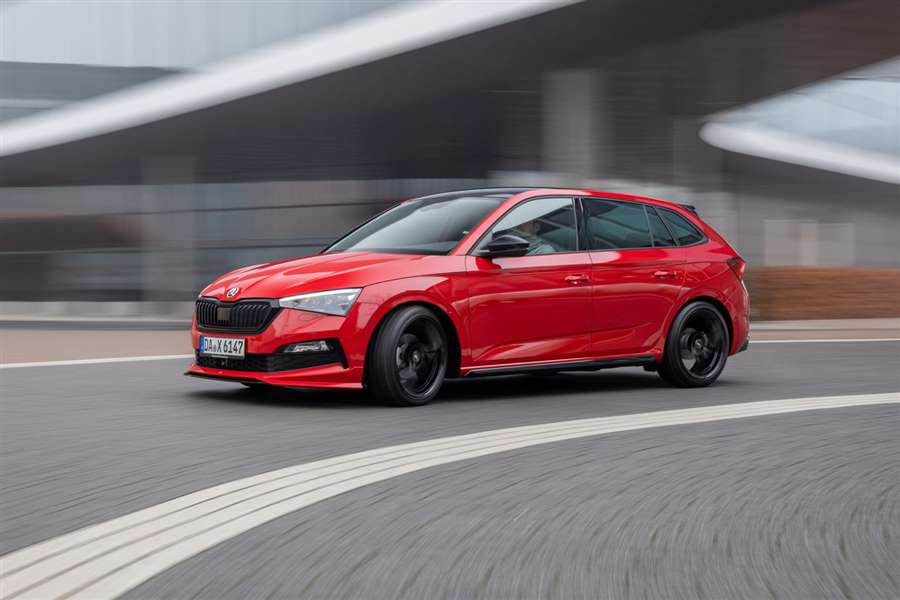
The Scala Edition S comes in a rich, Monte Carlo equipment package, and in addition to a modified engine, it also has a harder suspension. The vehicle is lowered by 15 mm compared to the standard Scala and is equipped with 18-inch alloy wheels, which are also signed by ABT. The Scala S also has improved aerodynamics, including a large diffuser on the lower part of the rear bumper.
The color offer consists of three options - Steel Gray, Black Magic Pearl Effect and Velvet Red Premium Metallic (like on a car with promo photos). Although ABT participated in the upgrade of the Scale S, the car will be made entirely in the Škoda factory. A limited series of 500 copies is planned, and the starting price in Germany is 33,790 euros. For comparison, the "ordinary" Scala Monte Carlo on the German market starts at 24,250 euros, and the much more powerful Octavia RS at 38,940 euros.
Vauxhall Vivaro-e Life review
Electric people carrier’s appeal limited by battery size
One of the most recent additions to the ranks of electric cars is the battery powered Vauxhall Vivaro-e Life, a zero-emission range to compliment the pre-existing diesel-only Vivaro Life range.
Plug-in cars enjoyed an enormous sales growth during 2020, largely at the expensive of diesel models, making a comparison of the relative virtues of these otherwise similar models particularly pertinent.
Just as the diesel Vivaro Life is a passenger-carrying MPV version of the latest Vivaro panel van, so it is with the electrified models, albeit with different battery capacities for the commercial Vivaro-e as covered throughout this review.
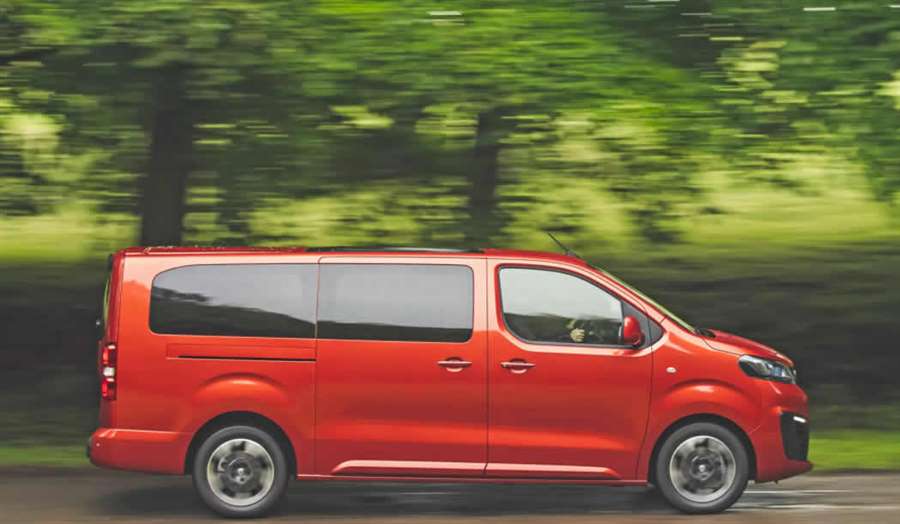
Direct rivals aren’t numerous at this stage, but they include the Citroen e-SpaceTourer and Peugeot e-Traveller, which, aside from styling differences at the front and a small number of detail changes, are identical to the Vauxhall. Interestingly, Toyota will not offer its equivalent version of the Proace Verso, even though it will sell an electric Proace van.
If you want something based on a totally different design, but still electric, your sole alternative (for now, at least), is the Mercedes-Benz EQV – a BEV version of the V-Class with a flurry of minor styling modifications.
What is the Vivaro-e Life’s driving range
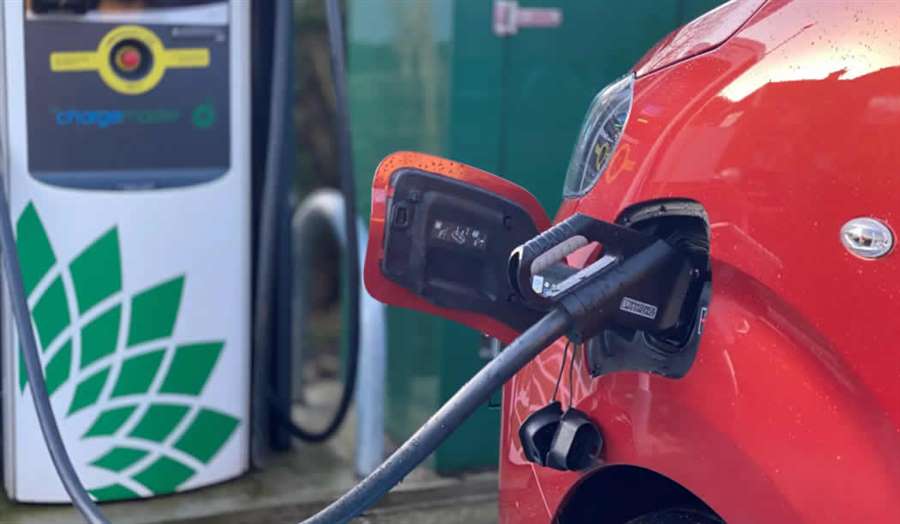
In a word, disappointing. Primarily this is because its battery pack, which is conveniently hidden under the floor and has zero impact on interior space, has a capacity of 50kWh. That’s fine in a more compact hatchback such as the electric Vauxhall Corsa-e, but in something the size of the Vivaro it restricts the distance it can travel between recharges badly.
Officially the range is 144 miles, but in the sub-zero temperatures we’ve tested the Vivaro-e Life in so far, it would only charge up to a displayed 128 miles, with a real-world range on a mixture of roads of 100.
That could be sufficient if it's being primarily for urban journeys as a taxi, but as a family bus it’s disappointing.
Frustratingly, Vauxhall doesn’t offer the electric Life with the same 75kWh that’s available in the Vivaro-e van. In the commercial application the range jumps to a more sensible – if not exactly startling – 205 miles, just shy of the Mercedes EQV at 213 miles.
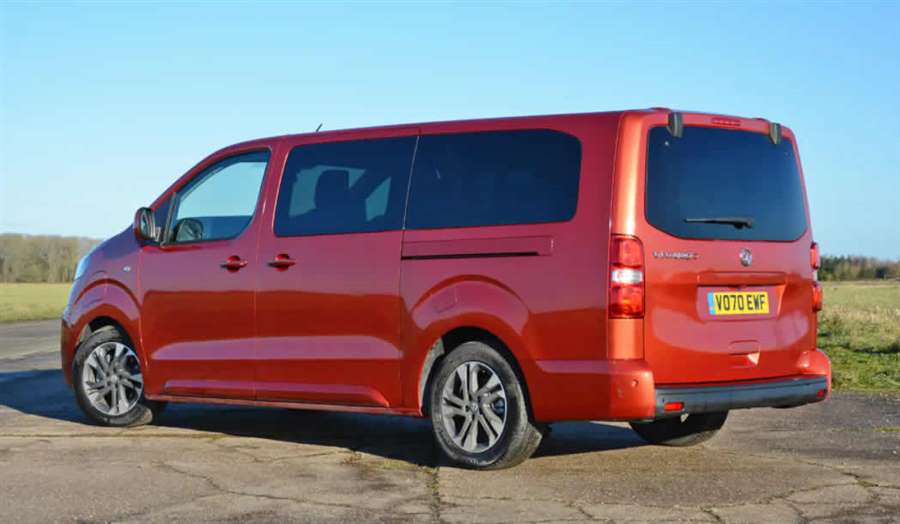
As ever recharge times depend on your connection, with a flat-to-full replenishment using a dedicated domestic wallbox taking 7.5 hours. On test, we found a ‘very low’ to full zap-up using a 50kW public charger could be done in around an hour.
Simple Vivaro-e Life line-up
With two trim levels – Edition and Elite – the electric Vivaro Life mirrors its diesel-engined twin, but beyond that the choice is even more straightforward.
Only one length of body is available (the longer one), there’s one 136hp electric motor option and it comes with a single-speed automatic transmission.

Entry-level Edition versions are easy to spot thanks to their largely unpainted bumpers and exterior mouldings, plus steel wheels with a plastic centre cap.
With a twin front passenger bench and three-person benches in rows two and three, the Edition is a nine-seater and not remotely plush inside. It’s aimed much more at private hire operators, businesses that shuttle employees around and families needing a large car on a budget, Air-con, cruise control and Bluetooth connectivity are included, but little else is as part of this sparse package.
Spending an extra £12,000 brings you a wealth of niceties rather befitting the Elite name. Among the long list of standard fare is a glazed roof panel, three-zone climate control, eight seats with a conventional, single-person, front passenger seat, leather upholstery, keyless entry, electrically sliding side doors and 17-inch alloy wheels to name but a few.
Should you wish to up the luxury ante a little more the middle-row bench seat can be replaced by a pair of captain’s chairs, complete with armrests and complemented by a fold-up table installed between them.
Comfier than diesel Vivaro Lifes
One of our chief critiques of the diesel counterpart was how unsettled the ride quality is when there are no passengers in the back.
Thanks to the weight of the batteries in the electric version, this is far less of an annoyance and in the most part isn’t an issue at all.
Not that you remotely buy a van-derived car such as the Vivaro-e Life for driving thrills, the weight of the batteries being so low within the vehicle’s structure also has a positive impact on how well it drives.
Nevertheless, it remains a car that’s easier to enjoy as a passenger rather than the driver, but none of the flaws of its diesel twin have been ironed out in the conversion to being an electric model as we describe later in the review.
Ordinarily, electric cars cost significantly more than their conventionally engined counterparts, but here the differential is around £3,000 – a very small figure to recoup in fuel savings.
New Renault 5 will have flashing lights (VIDEO)
A cult car from the seventies with flashing lights. Does that sound familiar to you? It is a cult R5. The French company has now revealed that the electric successor, shown last month, will take a lot of what the original Renault 5 had.
Nicolas Jardin, the exterior designer of the future Renault 5 model, reveals how the recognizable look of the original Renault 5 has been revived in a modern way.
Everyone will easily remember the mischievous and rebellious look that soon gained cult status, just like the car itself. Back in 1972, when this model arrived on the market, Renault gave its face to this look in the popular advertising cartoon Les aventures de Supercar.
Beautiful eyes were added to the headlights of the Renault 5, and so he set out to meet the French people. It is this classic and recognizable look that Nicolas Jardin wanted to revive in the Renault 5 Prototype model, while at the same time introducing it into the future.
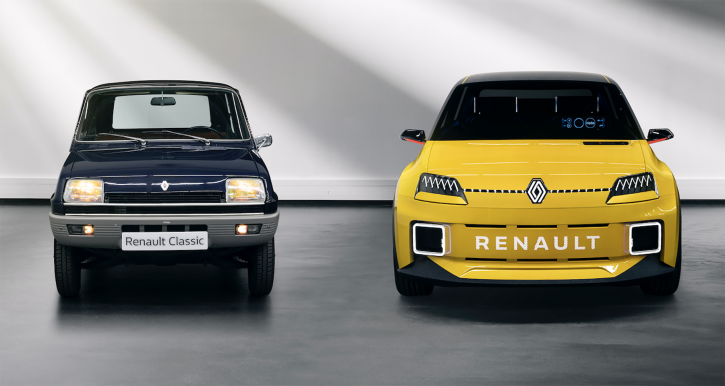
From a cult look to a new life
We have already written about the Renault 5 Prototype model, which was presented on January 14, when the future electric model was announced, which will be the successor to the original R5 model.
It should be noted that the designers ingeniously revived the original look of the 1972 version. They did not resort to retro design, but the recognizable elements of its cult ancestor are clearly visible from the prototype. From the very heart of the Technocentre, the place where Renault Group concepts and models are developed, Nicolas Jardin reveals how his project developed:
"We did not have unlimited freedom in working on this project. It was a reinterpretation of the R5 model and its transfer to the future. We had to design a modern product. "
In order to redesign the mischievous headlights and daytime running lights, “we started the design with the lines, angles and radii of the elements from the front of the original R5. Then, during the sketching, the headlights took on completely different dimensions and designs. "
Their final look is very elaborate, sculpted and reminiscent of eyes that laugh and are slightly wrinkled. The daytime running lights are rectangular in shape and are located at the bottom, reminiscent of the additional fog lights from the original version. As then, they are now housed on a body-colored front bumper. "Their crystal and three-dimensional processing as well as their extremely precise design are reminiscent of laser cuts, the world of aerodynamics and aeronautics."
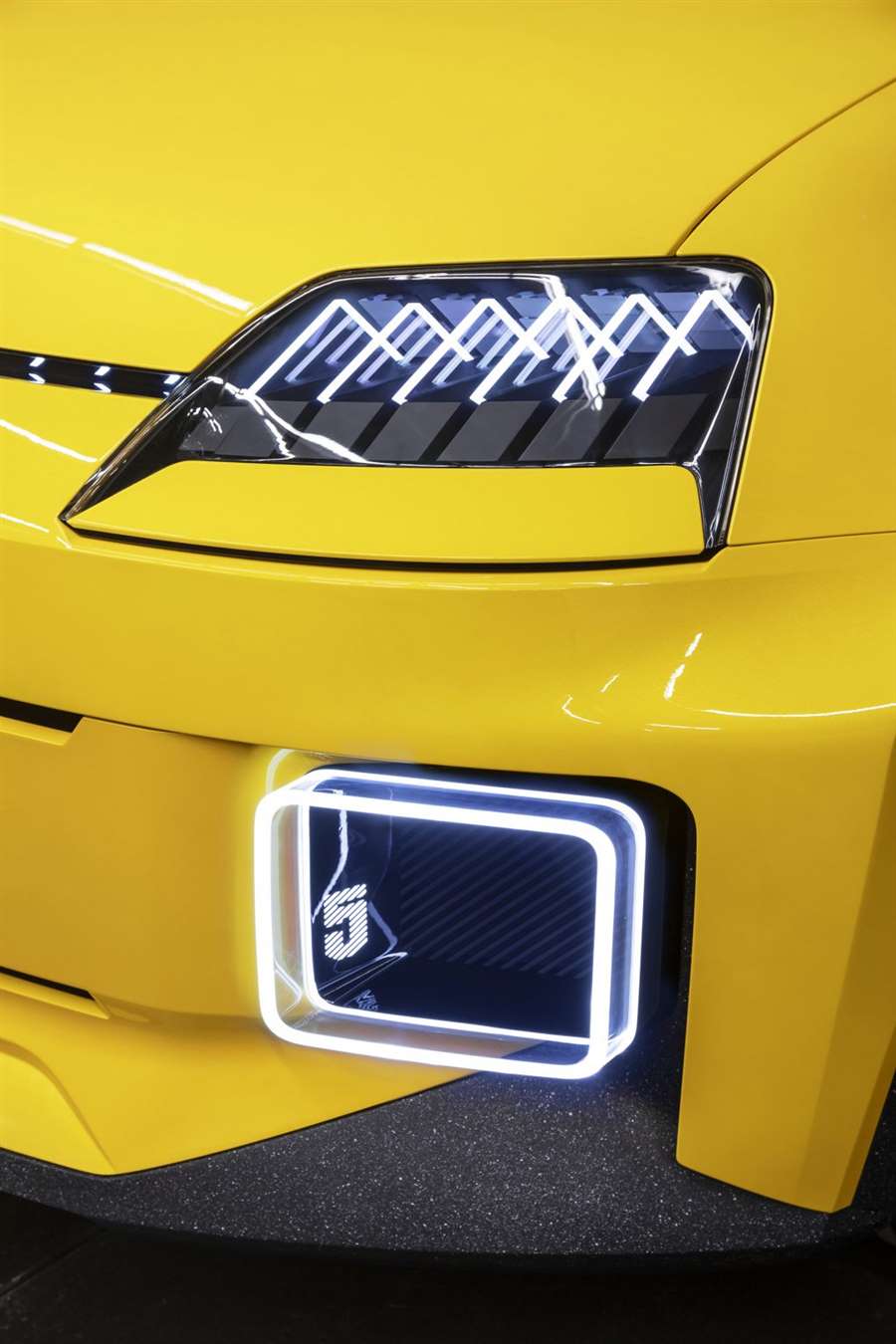
LED Matrix hint
Finally, ultramodern processes were used to revive the cult look of the R5. In particular, LED Matrix technology allows the installation of programmed animation with the help of which the lights come to life. This is evident from, for example, a series of lighting effects with which the car welcomes.
The new car logo is illuminated, launching an animation that extends into the front grille. Then the headlights come on, as if the car is winking. It is impossible not to notice that wink. "Thanks to Matrix technology and animations from the light greeting, we were able to repeat the expressiveness and mischievous look of the original car."
So, due to the design and light technology, the Renault 5 Prototype models on paper do not have much in common with the original R5 model. Still, our appearance is quite recognizable.
"To be a worthy successor to the R5, the car had to be expressive and lively. We managed to achieve that on this prototype, and it is a perfect example of modern design and the joy of living inherent in the Renault brand ", concluded Nicolas Jardin.
{vembed Y=zYqKA5jm1WI}

